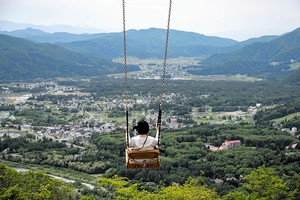THE ASSOCIATED PRESS
January 7, 2024 at 08:45 JST
WAJIMA, Ishikawa Prefecture--A woman in her 90s was pulled alive from a collapsed house five days after the magnitude-7.6 earthquake that killed at least 126 people.
The woman was rescued late Jan. 6 in Suzu city, officials said.
Nationally broadcast news footage showed helmeted rescue workers covering the view of the area with blue plastic sheets, and the woman was not visible.
Chances for survival diminish after the first 72 hours. Several other dramatic rescues have been reported over the past few days as soldiers, firefighters and others joined a widespread effort.
Among the 126 dead was a 5-year-old boy who had been recovering from injuries he suffered when boiling water spilled on him during the Jan. 1 temblor. His condition suddenly worsened and he died Jan. 5.
Aftershocks threatened to bury more homes and block roads crucial for relief shipments. Officials warned that roads already cracked could collapse completely. That risk was growing with rain and snow expected overnight and through Jan. 7.
Wajima city has recorded the highest number of deaths with 69, followed by Suzu with 38. More than 500 people were injured, at least 27 of them seriously.
The temblors left roofs sitting haplessly on roads and everything beneath them crushed flat. Roads were warped like rubber. A fire turned a neighborhood in Wajima to ashes.
More than 200 people were still unaccounted-for, although the number has fluctuated. Eleven people were reported trapped under two homes that collapsed in Anamizu.
For Shiro Kokuda, 76, the house in Wajima where he grew up was spared but a nearby temple went up in flames and he was still looking for his friends at evacuation centers.
“It’s been really tough,” he said.
Along Japan’s coastline, power was gradually being restored, but water supplies were still short. Emergency water systems were also damaged.
Thousands of troops were flying and trucking in water, food and medicine to the more than 30,000 people who had evacuated to auditoriums, schools and other facilities.
“I hope the city recovers, and I hope people won’t leave, and they stay here to work hard toward recovery,” said Seizo Shinbo, a seafood trader, who was stocking up on noodles, canned goods and rice balls at a supermarket.
“There is no food. There is no water. And the worst is gas. People are still in kilometer-long lines.”




















A peek through the music industry’s curtain at the producers who harnessed social media to help their idols go global.
A series based on diplomatic documents declassified by Japan’s Foreign Ministry
Here is a collection of first-hand accounts by “hibakusha” atomic bomb survivors.
Cooking experts, chefs and others involved in the field of food introduce their special recipes intertwined with their paths in life.
A series about Japanese-Americans and their memories of World War II